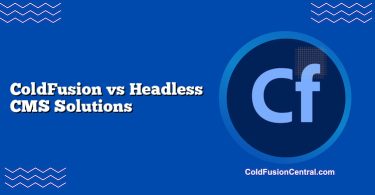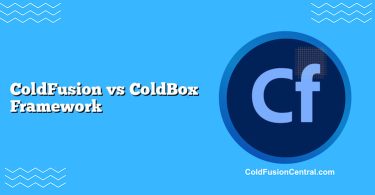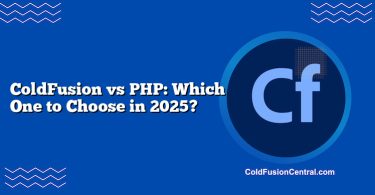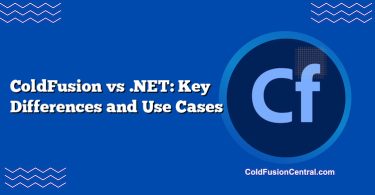Definitions
-
What is ColdFusion?
ColdFusion is a JVM-based web application platform and CFML (ColdFusion Markup Language) runtime. It offers a tag-based and script-based language for rapid server-side development, built-in services (PDF generation, scheduling, mail, image manipulation), and tight integration with databases and the Java ecosystem. Major engines include Adobe ColdFusion (commercial) and Lucee (open-source). -
What are Server-Side Rendering (SSR) frameworks?
SSR frameworks are JavaScript/TypeScript-based web frameworks that render HTML on the server for each request (or at build/edge time) to improve SEO, first paint, and perceived performance. Popular SSR frameworks include Next.js (React), Nuxt (Vue), SvelteKit (Svelte), Remix (React), and Astro. They run on Node.js or edge runtimes and often combine SSR with static generation, streaming, and client-side hydration.
Overview
ColdFusion and SSR frameworks both generate HTML on the server, but they differ in philosophy, ecosystem, and deployment:
- ColdFusion is a full-stack server platform with an integrated runtime, CFML language, and batteries-included services. It excels at rapid data-driven apps, back-office systems, and seamless integration with enterprise infrastructure.
- SSR frameworks are part of the modern JavaScript ecosystem, emphasizing component-based UI, routing, API routes, edge rendering, and hydration for interactive single-page app (SPA) experiences while retaining SEO advantages.
Think of ColdFusion as an application server with built-in features, and SSR frameworks as front-end-first platforms that also render on the server, then hydrate to a reactive client-side app.
Key Features
ColdFusion Highlights
- CFML language (tag-based and script-based) for rapid development
- Rich standard library: PDF/Office tools, mail, image, encryption, scheduling, WebSocket gateways
- Runs on the JVM; easy Java library integration
- Mature database access with query caching and ORM (Hibernate in Adobe CF)
- Built-in caching, session management, and monitoring (Enterprise)
- Engines: Adobe ColdFusion (commercial), Lucee (open-source)
- Mature frameworks: ColdBox, FW/1, Preside; dev tooling via CommandBox
SSR Framework Highlights
- Component-driven UI (React, Vue, Svelte) with server-side rendering and client-side hydration
- Flexible rendering strategies: SSR, SSG (static site generation), ISR (incremental static regeneration), and streaming SSR
- API routes/functions; can be serverless- or edge-deployed
- Vast NPM ecosystem and modern build tooling (Vite, Turbopack, Webpack)
- Easy integration with headless CMS, GraphQL, REST, and microservices
- First-class DX for routing, data fetching, and progressive enhancement
Performance
How a request flows (step-by-step)
-
ColdFusion (typical):
- HTTP request hits web server (IIS/Apache/Nginx) and CF connector.
- CFML code executes on the JVM, retrieves data, and renders HTML.
- Optional: page/fragment cache, query cache, or distributed cache returns content quickly.
- Response is sent; no hydration step is needed.
-
SSR Framework (typical Next/Nuxt):
- Request reaches Node/edge runtime.
- Server renders the component tree to HTML, fetching data on the server.
- Response streams to the browser (with streaming SSR when supported).
- Client downloads JS bundles and hydrates for interactivity.
Performance considerations
- Time To First Byte (TTFB):
- ColdFusion can deliver low TTFB for dynamic pages, especially with caching and minimal JS.
- SSR frameworks can achieve extremely low TTFB with edge rendering, ISR, and CDN caching.
- Throughput and resource use:
- ColdFusion excels with CPU-bound, data-heavy tasks on the JVM; query caching is effective.
- SSR frameworks offload repeatable pages to pre-rendered or cached HTML, reducing server load.
- Front-end performance:
- ColdFusion delivers server-rendered HTML; less client JS often means faster interaction for simple apps.
- SSR frameworks shine for complex, interactive UIs thanks to hydration and code-splitting.
- Streaming and partial rendering:
- Streaming SSR (React 18, Nuxt, SvelteKit) renders content progressively.
- ColdFusion can chunk responses but typically renders complete pages.
Bottom line: For data-heavy intranet apps with limited JS, ColdFusion can be extremely fast. For public websites requiring SEO and rich interactivity, SSR frameworks with edge/ISR often win.
Scalability
-
ColdFusion:
- Vertical scaling on robust JVMs is straightforward.
- Horizontal scaling via clustering/load balancers; session replication, sticky sessions, and distributed caches (EHCache, Redis) are common patterns.
- Docker images exist (Adobe/Lucee); works well behind Nginx/Apache/IIS.
-
SSR Frameworks:
- Scale horizontally as stateless Node processes or serverless functions.
- Edge deployment (Vercel, Netlify, Cloudflare) pushes rendering close to users.
- ISR/SSG drastically cuts runtime load by serving static HTML with selective regeneration.
If you prefer classic app servers and Java ops, ColdFusion scales well. If you want global edge footprints and serverless elasticity, SSR frameworks are designed for it.
Security
-
ColdFusion:
- Strong built-ins: input validation functions, CSRF tokens, session management, secure cookies, cfqueryparam to prevent SQL injection.
- Adobe ColdFusion ships with lockdown guides; Lucee offers security hardening and sandboxing.
- Risk profile: legacy apps sometimes lag on patches; misconfigurations (e.g., open admin endpoints) have historically led to exploits.
-
SSR Frameworks:
- Secure by design patterns available (CSP, Helmet, same-site cookies, frameworks’ route protections).
- XSS risks via unsafe rendering (e.g., dangerouslySetInnerHTML) if misused; supply chain vigilance needed in NPM.
- Serverless/edge platforms provide managed TLS, DDoS mitigation, and WAF integrations.
Security is strong on both sides when following best practices, updating dependencies, and enforcing least privilege.
Cost
-
ColdFusion:
- Adobe ColdFusion licensing (Standard/Enterprise) adds per-core or per-VM cost; support contracts available.
- Lucee is free and open source; paid support and commercial add-ons exist (Ortus Solutions, others).
- Ops cost: JVM expertise, application server maintenance, clustering.
-
SSR Frameworks:
- Frameworks are free; hosting ranges from low-cost VPS to managed platforms (Vercel, Netlify) with pay-as-you-go serverless and edge pricing.
- Developer availability in JavaScript/TypeScript is high; hiring costs can be favorable.
- Build/observability tooling costs vary (SaaS monitors, logs).
TCO depends on licensing choices (Adobe CF vs Lucee) and hosting model (self-managed vs fully managed edge).
Community Support and Ecosystem
-
ColdFusion:
- Smaller but dedicated community; enterprise focus.
- Ecosystem: ColdBox, CommandBox, TestBox, Preside CMS, ForgeBox packages.
- Vendor support from Adobe; active open-source Lucee foundation.
-
SSR Frameworks:
- Massive global communities across React/Vue/Svelte.
- Rapid release cadence, abundant tutorials and packages.
- First-class hosting/platform partnerships and integrations.
If you want a larger talent pool and faster-moving ecosystem, SSR frameworks deliver. For stability and long-lived enterprise apps, ColdFusion’s community is steady.
Real-World Use Cases and Scenarios
When ColdFusion is preferred
- Scenario: Internal operations portal for a manufacturing company
- Needs secure intranet access, PDF generation for purchase orders, scheduled reports, and tight integration with Oracle and Active Directory.
- Step-by-step:
- CFML app connects to Oracle with cfquery and uses cfdocument for PDFs.
- Scheduled tasks generate nightly summaries.
- LDAP integration authenticates staff; role-based security via sessions.
- Pages cached for high-traffic dashboards; minimal client JS.
- Why ColdFusion: Out-of-the-box services, rapid delivery, and JVM stability.
When SSR frameworks are preferred
- Scenario: Public e-commerce storefront
- Requires SEO, fast TTFB worldwide, product detail pages with rich interactivity, and integration with headless CMS and search.
- Step-by-step:
- Next.js renders product pages at the edge; ISR regenerates on updates.
- Client hydrates components for filters, carts, and real-time inventory.
- CDN caches HTML; analytics and A/B testing run via JS.
- Serverless functions handle checkout, payments, and webhooks.
- Why SSR: Global performance, modern UX, and flexible integration pipeline.
Side-by-Side Comparison
| Aspect | ColdFusion (CFML) | SSR Frameworks (Next.js/Nuxt/SvelteKit/Remix) |
|---|---|---|
| Primary Language | CFML on JVM (with Java interop) | JavaScript/TypeScript; React/Vue/Svelte components |
| Rendering | Server-side HTML; no hydration by default | Server-side HTML plus client-side hydration; can do SSG/ISR |
| Performance Focus | Fast dynamic rendering, strong query/page caching | Edge rendering, streaming SSR, code-splitting, ISR |
| SEO | Strong (server-rendered) | Strong (SSR/SSG/ISR) with rich client interactivity |
| Scalability | JVM vertical/horizontal, clustering, distributed caches | Horizontal scaling, serverless, edge compute, CDN |
| Ecosystem | Smaller, enterprise-focused; ColdBox, Preside | Huge NPM ecosystem; headless CMS, APIs, frameworks |
| Security | Mature features; requires patch discipline | Strong patterns; must manage XSS/CSRF and supply chain |
| Cost | Adobe licenses or free Lucee; ops-heavy JVM | Free frameworks; managed hosting costs; large talent pool |
| Best For | Back-office apps, reports, PDFs, rapid data apps | SEO-heavy sites, interactive UIs, global delivery |
| Learning Curve | Moderate; CFML easier than Java for many | Depends; JS/TS stacks widely known |
| Pros | Batteries included, JVM power | Modern UX, edge/ISR, massive ecosystem |
| Cons | Smaller community, licensing (Adobe) | Complexity of JS toolchains, bundle size/hydration costs |
Pros and Cons
ColdFusion Pros
- Rapid development with CFML and built-in services
- Strong database tooling and JVM performance
- Integrated scheduling, mail, PDF, and image manipulation
- Mature caching and session management
- Option to use Adobe CF support or free Lucee
ColdFusion Cons
- Smaller talent pool and ecosystem
- Adobe licensing costs (if not using Lucee)
- Perception as legacy; fewer modern UI patterns out-of-the-box
- Requires careful patching and secure configuration
SSR Framework Pros
- Excellent SEO plus SPA-like interactivity via hydration
- Edge rendering, ISR/SSG, and streaming for top-tier performance
- Massive NPM ecosystem and developer availability
- Flexible deployment: serverless, containers, or edge
SSR Framework Cons
- Complexity: bundlers, hydration, and build pipelines
- Risk of large JS bundles affecting LCP/INP if unmanaged
- Security and supply-chain hygiene required in NPM ecosystem
- Rapid change can mean frequent upgrades
Decision Factors / Which One Should You Choose?
-
Choose ColdFusion if:
- You need to build data-driven internal applications quickly with robust built-ins like PDF, schedulers, and mail.
- Your team is comfortable with JVM operations and CFML, or you want tight Java integration without heavy boilerplate.
- Stability and long-term maintenance on a smaller stack outweigh trendy ecosystems.
-
Choose SSR frameworks if:
- You’re building public-facing, SEO-critical sites that require rich client interactivity and global performance.
- You want to leverage serverless/edge, ISR/SSG, and a large talent pool in JavaScript/TypeScript.
- You prefer a component-driven UI with modern tooling and integrations.
Practical rule of thumb:
- For enterprise back-office and integration-heavy apps: ColdFusion (Adobe CF or Lucee) is highly productive.
- For consumer-facing sites/apps prioritizing UX and scale-to-zero/edge delivery: SSR frameworks are the better fit.
Supported Platforms and Deployment
-
ColdFusion
- Engines: Adobe ColdFusion (Windows/Linux; Docker images), Lucee (any OS with JVM; Docker)
- Web servers: IIS, Apache, Nginx via connectors
- Databases: SQL Server, Oracle, MySQL/MariaDB, PostgreSQL, others via JDBC
- Typical deployments: on-prem VMs, containers, cloud VMs; clustering with load balancers
-
SSR Frameworks
- Runtimes: Node.js, Bun, Deno (varies by framework), edge runtimes (V8 isolates)
- Hosting: Vercel, Netlify, Cloudflare, AWS Lambda, Fly.io, Kubernetes, any VPS
- Data sources: Headless CMS, REST/GraphQL, serverless DBs, traditional RDBMS
- Typical deployments: serverless functions, edge, or Node servers with CDN caching
Language and Development Model Notes
-
ColdFusion (CFML)
- Tag-based and script-based syntax; quick to prototype
- Server-side templates produce HTML directly; minimal client JS unless added
- Easy Java interop for leveraging existing libraries
-
SSR Frameworks (JS/TS)
- Component-driven development (React/Vue/Svelte) with declarative UI
- Server and client code coexist; hydration bridges both worlds
- Rich DX with hot reload, type safety (TypeScript), and testing tools
Key Takeaways
- ColdFusion is a robust, server-centric application platform with a focus on rapid delivery of data-heavy apps and built-in enterprise features.
- SSR frameworks are front-end-forward platforms delivering SEO-friendly pages and rich interactivity through hydration, with modern deployment models like edge and serverless.
- Performance is excellent on both sides, but the levers differ: caching/JVM power for ColdFusion versus edge/ISR/streaming for SSR frameworks.
- Cost and team skills often decide the winner: Adobe CF licensing vs. free Lucee, and Java/JVM skills vs. JS/TS skills in the market.
- Match the tool to the problem: ColdFusion for integrated enterprise apps; SSR frameworks for global, interactive, SEO-driven experiences.
FAQ
Is ColdFusion still relevant for new projects?
Yes. With Adobe ColdFusion and Lucee, the platform remains productive for enterprise applications, especially when PDFs, scheduled tasks, mail services, and database-heavy workflows are central. Many teams deploy Lucee to avoid licensing costs while keeping JVM reliability.
Can SSR frameworks replace a traditional application server?
They can for many use cases, especially public-facing sites. However, SSR frameworks often rely on external services for capabilities ColdFusion provides natively (PDF, scheduling, mail). You may need serverless functions or microservices to match “batteries-included” features.
How do I choose between Adobe ColdFusion and Lucee?
Choose Adobe ColdFusion if you want official enterprise support, particular enterprise features, and vendor backing. Choose Lucee if you prefer open source, lower cost, and community-driven development, possibly with paid support from specialized vendors.
Do SSR frameworks work well with legacy systems?
Yes. They can consume legacy APIs, SOAP/REST endpoints, or GraphQL gateways. Many teams keep legacy backends (including CFML apps) and use SSR frameworks for the front-end, progressively modernizing the stack.
What about static site generation (SSG) vs SSR?
SSG pre-renders pages at build time for very fast delivery. SSR renders on demand. Many frameworks mix both with ISR, serving static pages while revalidating in the background, balancing freshness and performance.




